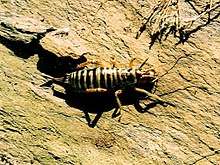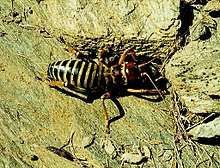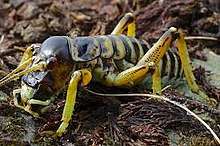Hemideina maori
Hemideina maori, also known as the mountain stone wētā, is a wētā of the Anostostomatidae family. They are a large, flightless, nocturnal orthopteran endemic to New Zealand. Mountain stone wētā are long lived and are found on many central mountain ranges in New Zealand's South Island.
| Hemideina maori | |
|---|---|
 | |
| Female | |
 | |
| Male | |
| Scientific classification | |
| Kingdom: | |
| Phylum: | |
| Class: | |
| Order: | |
| Suborder: | |
| Family: | |
| Genus: | |
| Species: | H. maori |
| Binomial name | |
| Hemideina maori | |
Taxonomy
Hemideina maori was first described in 1891 by Swiss Entomologists Alphonse Pictet and Henri de Saussure[1][2].
Habitat and Distribution
Unlike other Hemideina species H. maori occupy an alpine habitat[3]. They are found at high elevation (above the tree line) of the South Island of New Zealand. They have been found above 1500 metres above sea level (m.a.s.l) with a lower limit of 1100m.a.s.l, from the Kaikoura Ranges south to the Rock and Pillar range in Otago[3][4][5][6]. They use cavities under rock slabs ('tors') broken from schist outcrops as retreats during the day[3][4]. Tors are separated by alpine meadows with no rocks and therefore are assumed to have no wētā, causing population fragmentation[4].
The mountain wētā do not move far during their life time, and are exposed to high winds and low temperatures all year round[7].
Diet
Studies of mountain stone wētā frass have found that their diet may consists of many plant species and few invertebrate species[6]. All plant species preferred by H. maori have a higher than average lipid content[6].
There are few published studies of the diet of H. maori or of the intraspecific variation in their diet[8]. It is however known that they are omnivorous, feeding on plants and live and decaying matter[8].
Morphology

H. maori are a large wētā with a body length of approximately 6cm[3]. The length of the male and female tibia do not differ (mean of tibia length = 18.6 +/- 0.17 mm for each sex)[3]. Both males and females have directional asymmetry in mandible length with the left mandible being longer than the right (Males: median 0.53mm, range: 0.01 to 1.37mm, n=48. Females: median 0.49mm, range 0 to 1.21mm, n= 35)[3].
Males can show extreme dimorphism in weaponry that appears to be a result of sexual selection of male-male combat for access to females[3]. These males have mandibles that tend to be two times longer and their head can be up to 1.5 times wider than those of females with a similar tibia length[3].
Body Colour
A hybrid zone between the two colour forms (melanic and yellow) of Hemideina maori has been studied in the Rock and Pillar mountain range and[9][10]. It was found that both the black and yellow lineages in the Rock and Pillar range do not form a monophyletic group suggesting that H. maori exhibited a colour polymorphism before the separation of the two Rock and Pillar lineages occurred[9].
Physiology
Adaptation to Montane Environment
Cuticular water loss (CWL) and respiratory water loss (RWL) were found to be reduced in montane wētā compared to lowland wētā, suggesting that montane Hemideina have an increased desiccation resistance via decreased water loss[10]. It was also found that the black colour morphs lost less total water than yellow colour morphs driven by a decrease in CWL in the black morphs[10].
Freeze Tolerance

Mountain stone wētā can survive being frozen solid over winter and are estimated to be inactive for at least 5 months of the year[4]. During winter H. maori are often immobile with ice crystals on their cuticle, when touched the individuals appear to be frozen solid on warm days however, they can be found thawed and active under rocks[7]. While the wētā are immobile they are in a state of suspended animation, they can survive up to 17 days in temperatures of about -10 °C[7][11]. At temperatures below -10 °C, approximately 85% of their body water is crystallized, one of the highest ice contents known for any animal[11][12].
During winter, their haemolymph contains low molecular weight cryoprotectants such as amino acids, especially proline (up to about 100 mM) and the disaccharide trehalose[7]. These substances are synthesised during autumn and their concentration decreases again during spring and summer (proline concentration decreases to about 10 mM during summer)[7]. The amino acids and sugars presumably help to decrease the ice content colligatively; however, they probably also have a direct protective effect on membranes and proteins via direct interaction or by modifying the water layer with the closest proximity to the molecules[7].
Behaviour
Unlike other Hemideina species, H. maori is a species of tree wētā, which spends most of its time in tors on the ground[3][4][13]. Just like other tree wētā species however, H. maori leave their refuges at night to forage and oviposit in soil[3].
To defend against predators, mountain stone wētā will often "play dead"[14]. They lie still for a short time on their back, with legs splayed, claws exposed and jaws wide open ready to scratch and bite[14]. This behaviour is often accompanied with regurgitation when grabbed by a predator which can act as an irritant or toxin[15][16].
Predators

Potential mammalian predators of the mountain stone wētā appear to be present in either very low numbers or not at all at elevations above 1100 m.a.s.l, suggesting that rats, possums, cats and other potential mammalian predators have not dispersed into this area in large numbers[6].
This means that native nocturnal predators of the mountain stone wētā are most likely to be reptiles such as geckos and skinks or birds such as ruru (morepork)[9].
Breeding
Mountain stone wētā have a several year life cycle, they may take at least 4 years to reach sexual maturity with some individuals surviving at least 4 breeding seasons[3][4].
The H. maori mating season tends to end before the alpine cold period, (autumn is March & April in the southern hemisphere) this is a time when the days are cold and the wētā are inactive in their rock refuges[3].
Males cohabit with many females, (up to seven females with a single male) males that live with a large number of females have a higher chance of mating success[3]. Adult males have larger heads and elongated mandibles compared to adult females (secondary sexual dimorphism). H. maori have a harem-polygynous mating system, copulation tends to occur within their rock refuges with the ability to quickly mate with any female who returns to the retreat[3]. Males use their large mandibles in male-male fights for access to harems.
To copulate males move alongside females making their attennal in contact with her, they then curve their abdomen towards the females terminalia[3]. Copulation tends to last for a mean of 3.1 minutes[3].
Conservation Status
Populations of this widespread species are found on most ranges on the Southern Alps and therefore it is not considered to be at risk of extinction. A mark-recapture study conducted by Leisnham et al where 480 adult mountain stone wētā were marked, over the period of three field seasons (between November 1997 and April 2000) 72% of marked individuals (n = 229) were recaptured at least once[17].
References
- Johns, P. M (1997). "The Gondwanaland weta: Family Anostosromatidae (Formerly in Stenopelmatidae, Henicidae or Mimnermidae): nomenclatural problems, world checklist, new genera and species". Journal of Orthoptera Research. 6 (6): 125–138. doi:10.2307/3503546. JSTOR 3503546.
- Hollier, John (2011). "An annotated list of the Orthoptera (Insecta) species described by Alphonse Pictet (alone, and with Henri de Saussure) with an account of the primary type material present in the Museum d'histoire naturelle in Geneva". Revue suis se de Zoologie. 118 (2): 345–400.
- Gwynne, D. T; Jamieson, I (1988). "Sexual selection and sexual dimorphism in a harem-polygynous insect, the alpine weta (Hemideina maori, Orthoptera Stenopelmatidae)". Ethology Ecology & Evolution. 10 (4): 393–402. doi:10.1080/08927014.1998.9522852.
- Jamieson, I. G; Forbes, M. R; McKnight, E, B (2000). "Mark-recapture study of mountain stone weta Hemideina maori (Orthoptera: Anostomatidae) on rock tor 'islands'". New Zealand Journal of Ecology. 24 (2): 209–214.
- "Tree weta". wetageta.massey.ac.nz. Retrieved 2 July 2019.
- Joyce, Shelley Joanne (2001). "The survival, longevity, diet and development of mountain stone weta Hemideina maori in the Rock and Pillar Range, New Zealand". Thesis: 1–87.
- Ramlov, H (1999). "Microclimate and variations in haemolymph composition in the freezing-tolerant New Zealand alpine weta Hemideina maori Hutton (Orthoptera: Stenopelmatidae)". Journal of Comparative Physiology Biology. 169 (3): 224–235. doi:10.1007/s003600050215.
- Wilcon, G. C; Jamieson, I. G (2005). "Does melanism influence the diet of the mountain stone weta Hemideina maori (Orthoptera: Anostostomatidae)?". New Zealand Journal of Ecology. 29 (1): 149–152.
- King, Tania. M; Kennedy, Martyn; Wallis, Graham. P (2003). "Phylogeographic genetic analysis of the alpine weta, Hemideina maori: evolution of a colour polymorphism and origins of a hybrid zone". Journal of the Royal Society of New Zealand. 33 (4): 715–729. doi:10.1080/03014223.2003.9517755.
- King, Kieth. J; Sinclair, Brent. J (2015). "Water loss in tree weta (Hemideina): adaptation to the montane environment and a test of the melanisation-desiccation resistance hypothesis". The Journal of Experimental Biology. 218 (Pt 13): 1995–2004. doi:10.1242/jeb.118711. PMID 26157158.
- Wharton, D. A (1997). "Avoidance of intracellular freezing by the freezing-tolerant New Zealand Alpine weta Hemideina maori (Orthoptera: Stenopelmatidae)". J Insect Physiol. 43 (7): 621–625. doi:10.1016/s0022-1910(97)00018-8. PMID 12769972.
- Toki, Nicola (31 August 2012). "Cryogenic creepy crawlies". Stuff.co.nz. Retrieved 25 February 2017.
- Morgan-Richards, Mary; Trewick, Steve. A; Dunavan, Scott. "When is it coevolution? The case of ground wētā and fleshy fruits in New Zealand". New Zealand Journal of Ecology. 32.
- Field, L. H (2001). The Biology of Wetas, King Crickets and their Allies. pp. 40–41.
- Bidau, Claudio. J (2014). "Patterns in Orthoptera biodiversity. I. Adaptations in ecological and evolutionary contexts". Journal of Insect Biodiversity. 2 (20): 1–39. doi:10.12976/jib/2014.2.20.
- O'Brian, B (1984). "Mandibular movements and their control in the weta, Hemideina maori (Orthoptera: Ensifera: Stenopelmatidae)". Thesis: 1–222.
- Leisnham, P. T; Cameron, Claire; Jamieson, Ian. G (2003). "Life cycle, survival rates and longevity of an alpine weta Hemedina maori (Orthoptera: Anostostomatidae) determined using mark-recapture analysis". New Zealand Journal of Ecology. 27 (3): 191–200.